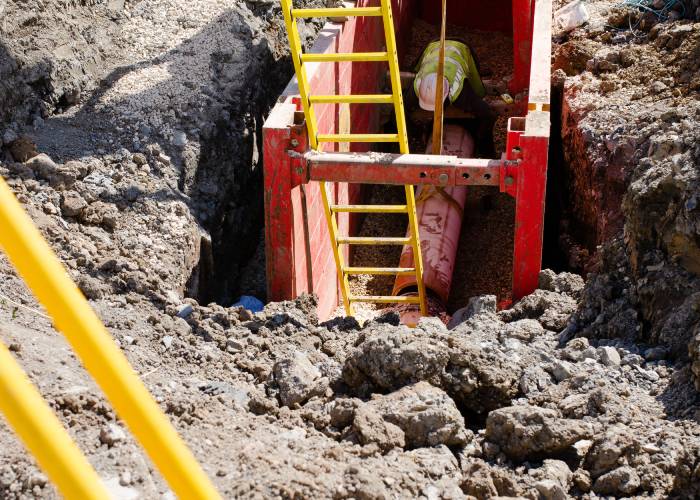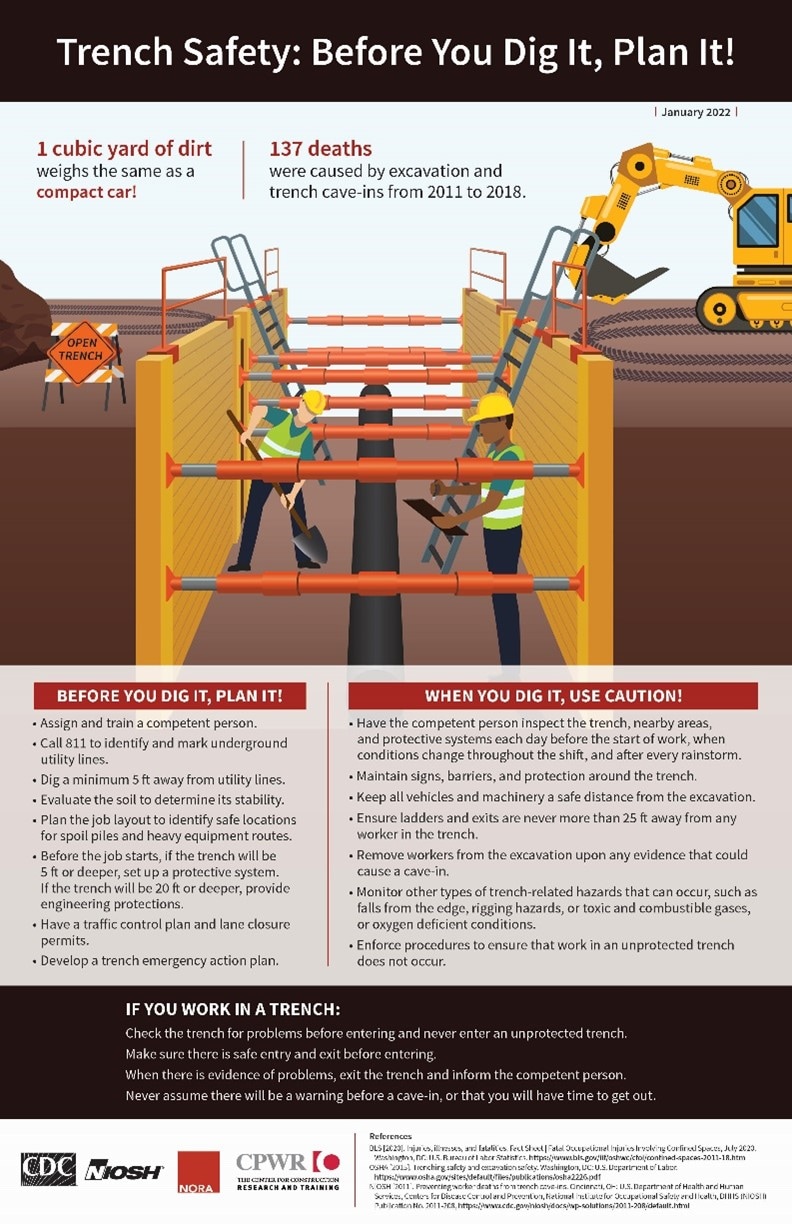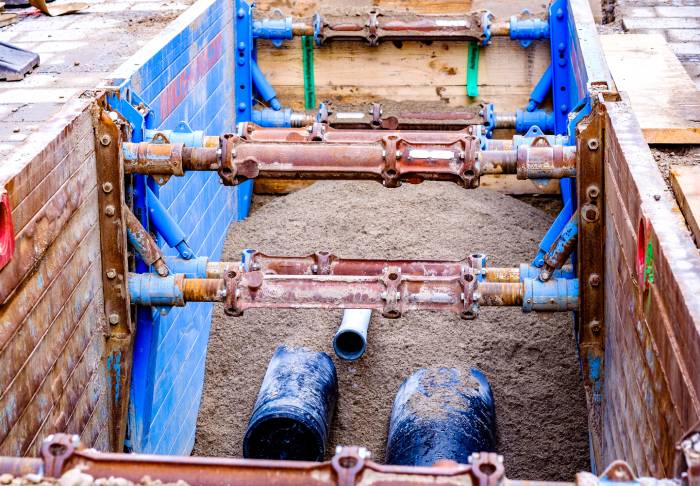Trenching and Excavation

Working in an unprotected trench is dangerous. The walls can collapse suddenly and without warning. When this happens, workers do not have time to move out of the way. A small amount of dirt may not seem dangerous, but one square yard can weigh more than 3,000 pounds—the weight of a compact car. This small amount of dirt is enough to fatally crush and suffocate workers.
Workers should never enter a trench that does not have a protective system in place.
The protective system should be designed and installed by a competent personexternal icon. A competent person can identify hazards and is authorized to correct them. Competent person training is available from many sources, including insurance companies, trade associations, labor unions, trenching safety equipment manufactures, and others.
Trench collapses are rarely survivable but completely preventable. Injuries and deaths associated with trenches continue to happen. From 2003 to 2017 there were a total of 373 trenching fatalities, with more than 80% of them in the construction industry. Engineering controls, protective equipment, and safe work practices can reduce hazards to workers and prevent trench cave-ins.
Trench Safety Month Takes Place Every June!
The National Utility Contractors Association has declared June 2022 Trench Safety Monthexternal icon. The event will highlight innovative educational and safety programs for worksites. Trench Safety Stand Downs will take place June 20–24, 2022.
National Stand-Down to Prevent Struck-by Incidents
Every April you can participate in or host a National Stand-Down to Prevent Struck-by Incidentsexternal icon. Take time during this week to learn about work zone safety, lift zone safety, heavy equipment, and dropped objects.


Figure 1. Trench box used to shield the trench against collapse.
The OSHA standard for excavations, including trenches, is 29 CFR* 1926 Subpart Pexternal icon. This standard describes the precautions needed for safe excavation work. OSHA requires that all excavations 5 feet deep or greater make use of one of the following protective system options:
- Sloping the ground
- Benching the ground
- Shoring the trench with supports such as planking or hydraulic jacks
- Shielding the trench (using a trench box) (See Figure 1 below)
To prevent trench collapse, planning is required before a job begins. Employers should
- Assign and train a competent person.
- Call 811 to identify and mark underground utility lines.
- Dig a minimum 5 feet away from utility lines.
- Evaluate the soil to determine its stability.
- Plan the job layout to identify safe locations for spoil piles and heavy equipment routes.
- Before the job starts, if the trench will be 5 feet or deeper, set up a protective system.
- If the trench will be 20 feet or deeper, provide additional engineering protections.
- Have a traffic control plan and lane closure permits.
- Develop a trench emergency action plan.
The best way to prevent trench collapse and trenching fatalities is to use other methods when possible. Some options include directional boring, relining the pipe, pipe ramming, and utility tunneling and pipe jacking. Robots can be used on construction sites to transport, line, and join large pipes to protect workers from serious injuries. Robots may reduce the need for pipe layers and other helpers to work at the bottom of the trench.
NIOSH Resources
Development of Draft Construction Safety Standards for Excavations. DHHS (NIOSH) Publication No. 83-103 (Volumes I & II)
NIOSH Fatality Assessment and Control Evaluation (FACE) program—The program identifies and investigates fatal occupational injuries. The FACE program aims to prevent occupational fatalities across the nation by identifying and investigating work situations at high risk for injury and then formulating prevention strategies to those who can intervene in the workplace.
NIOSHTIC-2 is a searchable bibliographic database of occupational safety and health publications, documents, grant reports, and journal articles supported in whole or in part by NIOSH.
Preventing Deaths and Injuries from Excavation Cave-Ins: NIOSH Alert. DHHS (NIOSH) Publication No. 85-110. Presents four case studies of worker deaths in trench cave-ins, as well as recommended work practices, overview of standards, and more.
Preventing Trenching Fatalities. NIOSH Science Blog—Describes the risks construction workers face when working in trenches.
Preventing Worker Deaths from Trench Cave-ins. DHHS (NIOSH) Publication No. 2011-208. En Espanol. Provides information on NIOSH recommended engineering controls, protective equipment, and safe work practices to minimize hazards for workers.
Trench Safety Awareness Web-based training. DHHS (NIOSH) Publication No. 2006-133D. A training on conducting a safe trenching operation. Topics include the four types of trench collapse, the frequency and cost of trench collapses, trench soil types, and common trench protective systems.
Trench Cave-ins: NIOSH Update. DHHS (NIOSH) Publication No. 93-110
Briefly describes worker deaths from trench cave-ins and provides recommendations for prevention. Summary of NIOSH Alert 85-110.
OSHA Resources
Construction eTool – Trenching and Excavationexternal icon
National Emphasis Program on Trenching and Excavationexternal icon
OSHA Standards for Excavationexternal icon
Trenching and Excavationexternal icon
Protect Workers in Trenches safety videoexternal icon (Spanishexternal icon)
Trenching and Excavation Safety Factsheetpdf iconexternal icon
Center for Construction Research and Training Resources
No New Year — Trench Collapse Video (Spanish)
Practice Trench Safety. It Saves Livesexternal icon Infographic (Spanishpdf iconexternal icon)
Trench Safety – Resources to Promote Safe Work in Trenches —CPWRexternal icon
Trenches Hazard Alertpdf iconexternal icon (Spanishpdf iconexternal icon)
Recent Trenching Fatalities: Causes and Ways to Reducepdf iconexternal icon
Trench Safety Toolbox Talkpdf iconexternal icon (Spanishpdf iconexternal icon)
Webinars
Increasing Awareness of Factors that Influence Trench Safety: external icon Learn about recent trends and a collaborative effort to increase awareness of the factors that may contribute to trenching incidents and ways to mitigate the risks. Download Presentation Slidespdf iconexternal icon
OSHA and American Society of Safety Professionals Share Trenching Safety Webinarexternal icon: Learn how contractors and workers can conduct excavation and trenching operations safely by following subparts of 29 CFR 1926, as well as the best practices described in industry consensus standards such as ANSI/ASSP A10.12.
